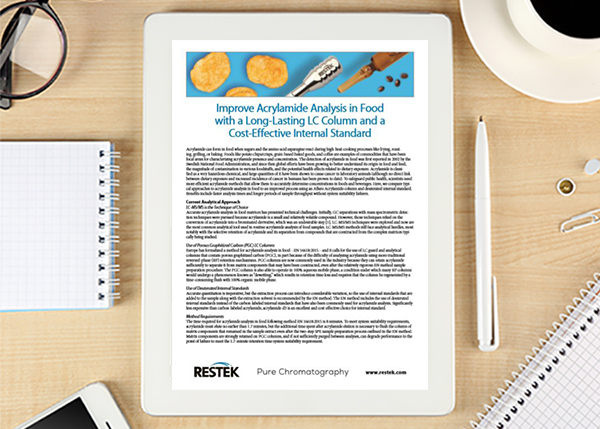Application note: Improve acrylamide analysis in food with a long-lasting LC column and a cost-effective internal standard
- Like
- Digg
- Del
- Tumblr
- VKontakte
- Buffer
- Love This
- Odnoklassniki
- Meneame
- Blogger
- Amazon
- Yahoo Mail
- Gmail
- AOL
- Newsvine
- HackerNews
- Evernote
- MySpace
- Mail.ru
- Viadeo
- Line
- Comments
- Yummly
- SMS
- Viber
- Telegram
- Subscribe
- Skype
- Facebook Messenger
- Kakao
- LiveJournal
- Yammer
- Edgar
- Fintel
- Mix
- Instapaper
- Copy Link
Posted: 16 July 2020 | Restek | No comments yet
In this application note, Restek compare typical approaches to acrylamide analysis in food to an improved process using an Allure Acrylamide column and deuterated internal standard.
Acrylamide can form in food when sugars and the amino acid asparagine react during high-heat cooking processes like frying, roasting, grilling, or baking. Foods like potato chips/crisps, grain-based baked goods, and coffee are examples of commodities that have been focal areas for characterising acrylamide presence and concentration. The detection of acrylamide in food was first reported in 2002 by the Swedish National Food Administration, and since then global efforts have been growing to better understand its origin in food and feed, the magnitude of contamination in various foodstuffs, and the potential health effects related to dietary exposure. Acrylamide is classified as a very hazardous chemical, and large quantities of it have been shown to cause cancer in laboratory animals (although no direct link between dietary exposure and increased incidence of cancer in humans has been proven to date).
Related content from this organisation
- Keep abreast of the latest food safety updates
- Food Safety In-Depth Focus – October 2020
- Application note: Robust analysis of fatty acids in milk
- Application note: Improve acrylamide analysis in food with a long-lasting LC column and a cost-effective internal standard
- Application note: Pyrrolizidine Alkaloids on Raptor ARC-18










